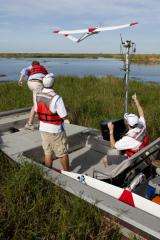UF team's work pays off with unmanned-flight system that captures valuable data

On an airboat on Lake Okeechobee, four University of Florida researchers prepare to launch an airplane -- by hand.
They check its altitude and attitude, turn the 11-pound plane side to side, lift its nose and lower it. They test wind speed, direction, the plane’s GPS system and autopilot.
“Three ... 2 ... 1,” the plane gets a shove from doctoral candidate John Perry and it’s airborne, flying in laptop computer-controlled patterns over the lake. Passing about 650 feet overhead, it sounds like a vacuum cleaner from a neighbor’s home. Farther off, it makes no noise at all. When it lands next to the airboat a half-hour later, it barely makes a splash.
The plane is the result of a decade’s worth of work by a multidisciplinary research team headquartered at UF’s Institute of Food and Agricultural Sciences. There has been a near-constant honing of what’s called the Unmanned Aerial System before researchers settled on today’s aircraft, which is durable, watertight, and takes incredibly sharp GPS-pinpointed photographs.
Later, those photographs create elaborately detailed maps, which provide data not available anywhere else for scientific research. In this case, the goal is to help gather information on plant life, but researchers say the tiny plane offers a vastly safer and more accurate way to conduct all kinds of environmental monitoring.
Despite its high gee-whiz quotient, said Larry Taylor of the U.S. Army Corps of Engineers, what’s important isn’t how nifty a gadget the plane is: It’s what it can do.
During the 30-minute flight, the plane takes and stores about 750 photographs. With the help of global positioning technology, the researchers know with startling accuracy the location of the area shown in each photo.
UF’s Matt Burgess, who helps coordinate the team’s activities, returned from a recent Alaska meeting of unmanned aerial systems researchers with the impression that UF leads the nation’s universities in capability to use information gathered from flights of similar types of planes.
The possibilities for this technology to help wildlife biologists are nearly endless, the researchers say. They include being able to count wading birds’ nests or even the eggs inside; counting the alligators in a swamp and documenting landscape components, such as trees or vegetation.
Aquatic vegetation was the focus of the team’s Lake Okeechobee outing. Members sent the plane up to photograph water lettuce and hyacinths left in a roughly ⅓-mile square of lake surface after federal officials used herbicide to thwart the invasive plants six weeks earlier.
There are three flights this day — two taking standard color photographs and a third to get color-infrared images. The only apparent disturbance to nature occurs during one of the landings, which startles a water bird enough to make it scoot to another spot.
The airplane flies using a lithium battery, so there’s no exhaust to pollute the air or hurt wildlife.
“It’s a green system,” Perry said. “It replaces the alternatives of manned aircraft such as helicopters and low-flying planes, and it produces better data.”
The plane is just a couple of years away from being available for general use, said Franklin Percival of the UF-affiliated Florida Cooperative Fish and Wildlife Research Unit, who’s led the team since it began.
“We’ve concentrated all these years on the plane and payload, and now we’ve got all of those things right,” he said.
The idea for the work began percolating in Percival’s head in the late 1980s, during a trip with a group of wildlife biologists who were heading into such rough terrain that they had to get there on an airboat led by a helicopter.
“Nobody wanted to fly in that thing. It was hot, and you’re flying [at altitudes] anywhere from 10 feet to 100 feet and it’s dangerous. And I was just thinking, ‘There has got to be a better way of doing this.’”
The project has so many state and federal agencies involved, including UF’s Department of Mechanical and Aerospace Engineering, School of Forest Resources and Conservation, and department of wildlife ecology and conservation, the U.S. Army Corps of Engineers, the U.S. Geological Survey, the Florida Fish and Wildlife Conservation Commission and the U.S. Fish and Wildlife Service, that much of Percival’s work involves keeping the group together — and keeping it funded.
He has described the team of students and biologists, as being like a football team “filled with Tim Tebows.”
Taylor, sitting atop a nearby airboat on the morning of the Lake Okeechobee launches, said the plane’s evolution in the last few years is nothing short of miraculous.
“With the previous airframe, it was like, ‘Please, God, let it get back down,’” he said. “But this one is just completely different. We’re really fortunate … the talent we’ve got on this team is just nuts.”
Provided by University of Florida




















